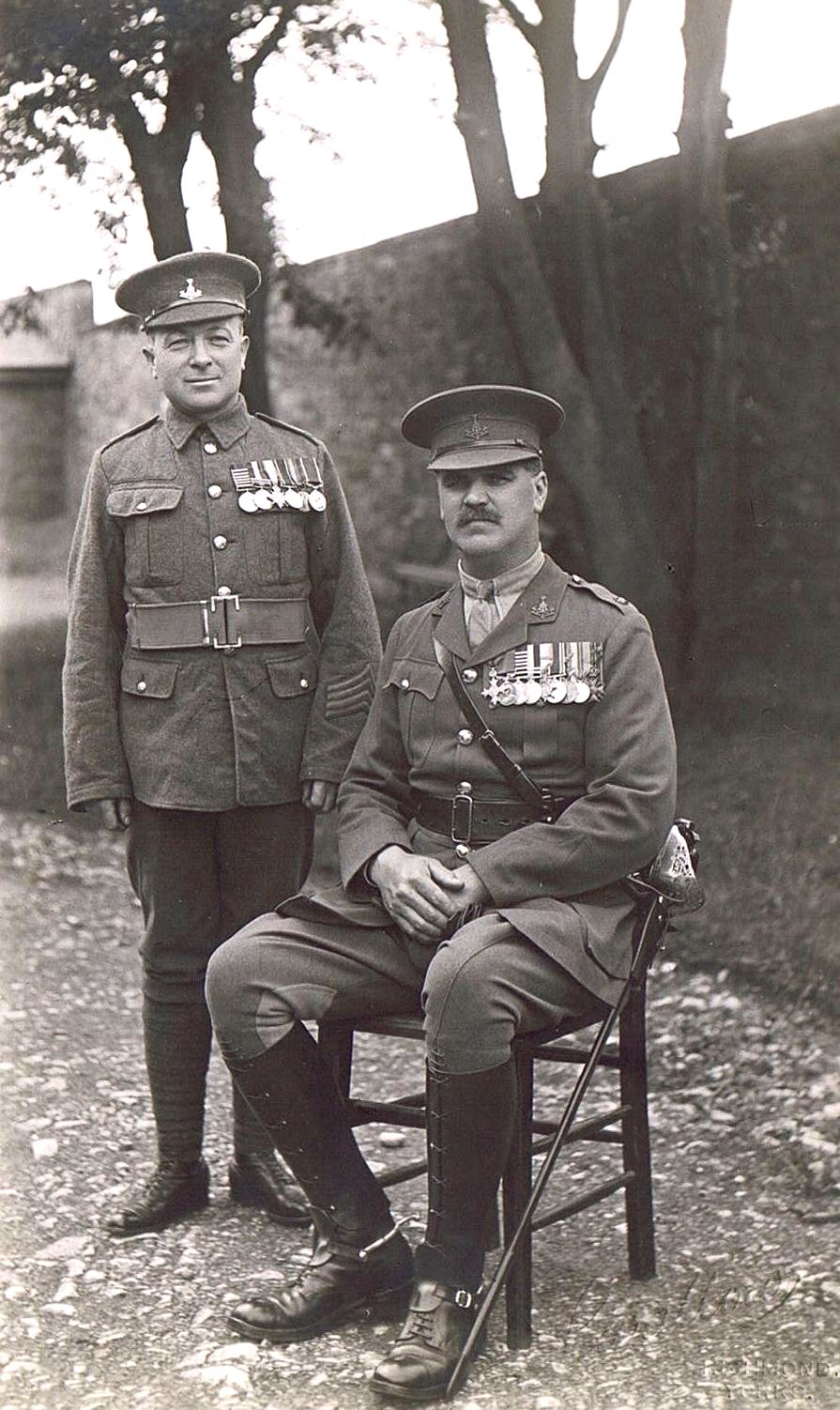
When Edward Pickard died in 1928 at the age of 56 he had given 36 years of his life to the Green Howards. Most of the town of Richmond turned out to his funeral on Friday July 21st with the mourners being headed by General Sir Edwin Bulfin, Colonel of the Regiment from 1914 to 1939.
Edward Pickard enlisted as a Green Howard in 1891, and rapidly rose through the ranks. He was one of very few officers to fight with his unit throughout the First World War, during which he served as Quarter Master to the 2nd Battalion. Pickard was the first Green Howard to fire at the enemy in the First World War – shooting two Uhlans (German mounted lancers) while trying to allocate billets to his men in Ypres! His ‘batman’ or servant, Charles Porteous Hellings who was with Pickard for a total of 14 years survived the war and is pictured here with Pickard in the grounds of the Depot in Richmond.
Explore more memories from the ribbon
-
William Whitesmith Constantine
William was born in Middlesbrough on the 26th March 1887. He was the son of Joseph and Maria Constantine of Harlesly Hall Northallerton. He was one of five offspring, having 2 sisters and 2 brothers. His father ran a shipping company which he had started in 1885 and would last until it was sold off in 1960. At the outbreak of WW1 the company had 28 vessels, 22 being ocean going and 6 coastal. During the war 13 of the company vessels and 32 crewmen would perish. William was gazetted into the Yorkshire Regiment as a 2nd Lieutenant in March 1906, promoted to Lieutenant 27th May 1907, and to Captain 5th October 1913. He served in France with the 4th Battalion. He suffered gassing at Ypres on the 24th May 1915 and was wounded on the Somme on the 15th September 1916. In 1916 he was awarded the Military Cross for ‘conspicuous gallantry in action’ which was cited in the London Gazette on the 14th November 1916. He had been promoted to Major on the 13th June 1916. On the 2nd May 1918 he was posted to The 2nd Battalion the Yorkshire Regiment, then in August to the 9th Battalion the King’s Own Yorkshire Light Infantry. The family were associated with Constantine College in Middlesbrough having donated £40,000 towards the building cost. The college opened in 1930. William died on the 11th November 1970 and was buried at the Church of St. Oswald, East Harlsey where he had been Churchwarden…
-
Horace Stoney
Horace Stoney was born on 7th December 1897. He was baptised in February 1898 at the Free Methodist Chapel, in Leeds close to where they were living at the time. At the age of 13 he was working as an office boy for an engineer and living at home with his parents in Leeds. On 10th December 1915, three days after he turned 18 Horace went to Leeds, joined the Royal Army Service Corp (RASC) and was posted to the Army Reserve. His service record includes the statement: “Transferred to Learners’ Section” on 10th October 1916. A contract survives, signed by Horace the day previous, declaring that he joined the RASC with a view to be trained as a Motor Transport Driver. Success would guarantee him an additional 1 shilling per day in pay, and provide him with a skill to use after the war. The RASC ensured that ammunition, food and equipment was delivered forming a complex supply network. Horace survived the war, although he contracted malaria, and was discharged in 1919. The 1939 Register lists him as living with his parents, John and Sarah, and his aunt Harriet, at his childhood home in Leeds. He was working as a Clerk Store Highway Constable and although he is listed married, his wife is not mentioned on the record.
-
Rees Brothers
George Frederick Gywn Rees and his younger brother Charles Bernard Russell Rees from Leicestershire both joined the Yorkshire Regiment during the First World War. Their parents, Sydney and Margaret Rees were relatively wealthy and they lived in Sheffield for much of their childhood. Sydney was a Church of England clergyman. Born only 1 year apart, George in 1895 and Charles in 1896, it would appear that they took similar paths through their early life. In the 1911 census they were both recorded as living at a boarding school in Workshop along with several hundred other boys. George and Charles both joined the 5th Battalion of the Yorkshire Regiment in 1915. Unfortunately their service records do not appear to have survived but museum records track their military careers from 1915 to 1918. George was wounded twice, in November 1916 and in June 1917, but neither wound appears to have affected his career as he was promoted to acting Captain in July 1917. Charlie however appears to have made it through the war relatively unscathed. Other than various promotions he is not listed until June 1918 as missing, turning up as a Prisoner of War in September. He returned home in late 1918 to Scrayingham Rectory, Stamford Bridge, York. Charles’ medal card records that he received the Victory Medal and the British War Medal. Both brothers survived the war but we do not know what happened to them later in life.
